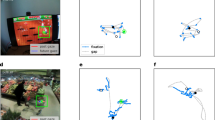Summary
1. We studied the latencies and amplitudes of saccades to moving targets in normal human subjects. Targets underwent ramp or step-ramp motions. The goal was to determine how the saccadic system uses information about target velocity. 2. For simple ramp motion saccadic latency decreased as target speed increased. A threshold distance model, which assumes that the target has to move a minimum distance before saccadic processing starts, provided a good fit to the responses of all four subjects and explains discrepancies between previously published findings. 3. A double step experiment showed that target position may have some effect on saccadic amplitude when sampled ≈70 ms before saccade onset, but it must be sampled at least 140 ms before onset for an accurate saccade to occur. 4. Saccades to simple ramp targets approximated the target position 55 ms before saccade onset. Based on our double step results, this is more compensation than possible by a simple position estimate and implies extrapolation of target motion by the saccadic system. The lack of complete compensation may be due to an underestimate of the target speed and/or of the saccadic latency. 5. A delayed-saccade paradigm resulted in saccades with a longer, constant latency and allowed longer viewing of target motion. These saccades accounted for all but ≈20 ms of target motion, suggesting that with more processing time of target motion a better extrapolation may be generated. 6. In a step-ramp paradigm the target stepped in one direction, then moved smoothly in the opposite direction. Saccades in this paradigm could be made in either the direction of the step or in the direction of target motion: the direction and latency were determined solely by the time at which the target crossed the fixation point. This time must be calculated from target speed and position, implying that the saccadic system must use speed information to adjust latency or to cancel unnecessary saccades.
Similar content being viewed by others
References
Becker W (1988) Metrics of saccades. In: Wurtz RH, Goldberg ME (eds) The neurobiology of saccadic eye movements: reviews of oculomotor research, Vol III. Elsevier, Amsterdam, pp 13–67
Becker W, Jürgens R (1979) An analysis of the saccadic system by means of double step stimuli. Vision Res 19:967–983
Carl JR, Gellman RS (1987) Human smooth pursuit: stimulusdependent responses. J Neurophysiol 57:1446–1463
Collewijn H (1972) Latency and gain of the rabbit's optokinetic reactions to small movements. Brain Res 36:59–70
Findlay JM, Harris LR (1984) Small saccades to double-stepped targets moving in two dimensions. In: Gale AG, Johnson F (eds) Theoretical and applied aspects of eye movement research. Elsevier Science Publishers, pp 71–78
Hays AV, Richmond BJ, Optican LM (1982) A UNIX-based multiple process system for real-time data acquisition and control. WESCON Conf Proc 2:1–10
Heywood S, Churcher J (1981) Saccades to step-ramp stimuli. Vision Res 21:479–490
Jürgens R, Becker W (1974) Is there a linear addition of saccades and pursuit movements? In: Lennerstrand G, Bach-y-Rita P (eds) Basic mechanisms of ocular motility. Pergamon, Oxford London, pp 525–529
Keller EL, Johnsen SDS (1990) Velocity prediction in corrective saccades during smooth-pursuit eye movements in monkey. Exp Brain Res 80:525–531
Newsome WT, Wurtz RH, Dursteler MR, Mikami A (1985) Deficits in visual motion processing following ibotenic acid lesions of the middle temporal visual area of the macaque monkey. J Neurosci 5:825–840
Rashbass C (1961) The relationship between saccadic and smooth tracking eye movements. J Physiol Lond 159:326–338
Robinson DA (1963) A method of measuring eye movement using a scleral search coil in a magnetic field. IEEE Trans Bio-Med Electron BME- 10:137–145
Robinson DA (1965) The mechanics of human smooth pursuit eye movement. J Physiol Lond 180:569–591
Robinson DA (1973) Models of the saccadic eye movement control system. Kybernetik 14:71–83
Ron S, Vieville T, Droulez J (1989) Target velocity based prediction in saccadic vector programming. Vision Res 29:1103–1114
Segraves MA, Goldberg ME, Deng SY, Bruce CJ, Ungerleider L, Mishkin M (1987) The role of striate cortex in the guidance of eye movements in the monkey. J Neurosci 7:3040–3058
Wyman D, Steinman RM (1973) Small step tracking: implications for the oculomotor “dead zone”. Vision Res 13:2165–2172
Zee DS, Tusa RJ, Herdman SJ, Butler PH, Gucer G (1987) Effects of occipital lobectomy upon eye movements in primate. J Neurophysiol 58:883–907
Author information
Authors and Affiliations
Rights and permissions
About this article
Cite this article
Gellman, R.S., Carl, J.R. Motion processing for saccadic eye movements in humans. Exp Brain Res 84, 660–667 (1991). https://doi.org/10.1007/BF00230979
Received:
Accepted:
Issue Date:
DOI: https://doi.org/10.1007/BF00230979




